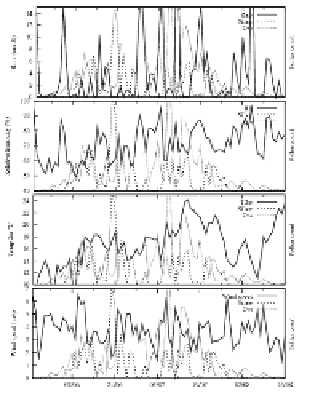Environmental Engineering Reference
In-Depth Information
3. Results and Discussion
Figures 1a
and
1b s
how observed and predicted pollen counts in Moscow together
with the most important weather factors: Rain, relative humidity, 2 m temperature
and wind speed. It should be kept in mind that all meteorological parameters are
taken from the weather prediction model and, consequently, are prone to errors.
Relative humidity and especially rain are very important for pollen concen-
trations both in grass and birch case and not only in Moscow. If it is raining or
relative humidity is too high, pollen concentrations become low or zero. Because
of the systems sensitivity to rain and humidity, it can sometimes explain negative
correlation in observed and predicted pollen counts, such as those presented in
Grass pollen concentration correlates clearly with 2 m temperature in several
places in Europe especially in the model output, but also in the observations. This
is not always held since rain and humidity can prevent high pollen counts even if
temperature is high but in general the relation is strong. Positive correlation bet-
ween temperature and birch pollen counts can also be seen, but it is not as clear as
in grass pollen case, because observed/modelled birch pollen represent pollen
from larger area.
Wind speed does not seem to correlate with pollen counts at all, at least at daily
level. Since the diurnal variability is very large, averaging over 24 h may appear
far too long to detect the link. It can also be masked by other factors, such as tempe-
rature, rain and humidity.
(a) (b)
Fig. 1. (
a)
Birch (b) grass pollen concentrations in Moscow in spring 2008. Dash line: SILAM
pollen concentrations, dotted line: observed pollen concentrations, solid line: daily averages of
weather parameters (rain, relative humidity, 2 m temperature or wind speed)


